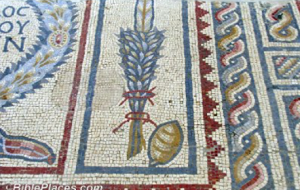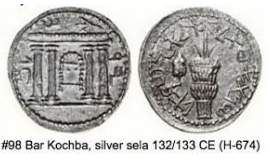In Part One of this two-part series entitled, Sukkot: Follow the Cloud of God, we examined what Sukkot is, what the common symbols of Sukkot are-the 'four species' (citron, palm, myrtle, and willow), as well as the Torah-and how, even during the Holocaust, the Jewish people did not shy away from observing and remembering Sukkot.
In this final part, we will examine the importance of Sukkot through her artifacts before diving into how the Jewish roots of our faith benefit all. We will see how Sukkot allows us to discover the importance of following 'The Cloud'-God's Presence and Glory-as it brings us not only into closer relationship with Him but allows us to experience the fullness of His blessings and benefits.
Sukkot Symbols Found in Archaeology and History:
(Credit: YadVashem.org; Architect: Abraham van Oosten.
Stained glass window crafted for a synagogue in 1932, in
Essen, Netherlands. Top Left: Sukkah; Top Right: Shofar;
Bottom Left: 'Four Species'; Bottom Right: Candle.)
As discussed in Part One of this two-part blog series, the symbols of Sukkot are perhaps the most unique found in the archaeological record. The use of the 'four species'-citron, palm, myrtle, and willow-together, is tied solely to Sukkot. But even when these symbols are used individually, they are often still linked to Sukkot, particularly with the use of the citron. Furthermore, these artifacts are not only found in Israel, but all around the world!
One example is seen in the stained glass window ABOVE. Designed by a Jew before the Holocaust and originally found in a synagogue in Essen, Netherlands, it somehow survived the Nazi invasion of the Netherlands and the deportation of the Essen Jews-most of whom, unlike this stained glass window, did not survive.
Despite their distance from the Promised Land, this Jewish artisan chose to craft the stained glass with imagery of tradition and the Word-the left half depicting a sukkah and the 'four species,' thus solely connecting it to Sukkot. Through this usage, we see that the importance of God's Feast did not depart from the memory of His people-even as the world around them made it safer to forget.
Yet, while distance did not diminish the importance of fulfilling God's Feast in the minds of His people, Israel has perhaps some of the oldest and most stunning archaeological depictions of Sukkot…
(Credit: BiblePlaces.com. Tiberias synagogue mosaic
depicting the 'four species' of Sukkot.)
In a Tiberias synagogue that is over one thousand years old, the 'four species' were prominently depicted in a costly mosaic. Those entering the synagogue, particularly the Rabbis who saw it daily, would have been reminded of God's Commandments, His Law, His Word, and of course, His commanded feast. Not only is this example-shown ABOVE-a reminder of God's instruction to the Jewish people, but it is stunning in its meticulous detail!
(Credit: tmsifting.org. First Revolt ¼ shekel coin from the Temple
Mount in Jerusalem, dating from 69-70 A.D.-before the Second
Temple destruction in 70 A.D. Made of bronze, one side depicts
a goblet and reads, 'For the redemption of Zion.' The reverse
depicts the 'four species' and reads, '4th year'-this references
the 4th year of the revolt against Roman rule.)
(Credit: amuseum.org. Silver coin from the Bar Kochba
-or Second-Revolt, 132-133 A.D. One side depicts
the Temple, the reverse, the 'four species.')
Even everyday objects included symbols of Sukkot-reminders of God's Presence, Glory, and the physical ingathering of crops….
Coins for instance, were often used to display aspects of the Temple or holy days such as Sukkot. ABOVE Bar Kochba era coins, rendered during the First Revolt, include the 'four species' during a time when the Jewish people fought for their right to serve God in the land promised to them. These everyday items held symbols that contained their desire for religious freedom while allowing all who used them to be reminded of their God-His instruction always before their eyes.
Are the 'four species' the only ties to Sukkot found in the archaeological/historic records?
No. Because Sukkot is also connected to ingathering-harvest-and while the 'four species' harken unto that, there is more still…
(Credit: Leon Mauldin. Gezer Calendar found in 1908. Inscription in
ancient Hebrew giving the seasons for crops; lower left-hand
corner has the name of the scribe, Abijah.)
Some twenty miles from Jerusalem, in the town of Gezer, a 10th century BC calendar was found. The calendar tells of the planting, harvesting, and pruning cycles of all the crops the ancient Jews would have grown. It gives the seasons for God's people, such as the season of ingathering-the time of Sukkot-and would have been a valuable tool of the day.
As Solomon wrote in Ecclesiastes 3:1, "To everything there is a season," we see that God's people in centuries past-as today-knew this. There are times and seasons to bring offerings to the Lord; times and seasons to prepare, sow, and harvest crops; times and seasons to celebrate the Lord through His feasts, such as Sukkot. And through calendars such as these, through the Torah giving the times and seasons of the Lord, God's people always held a 'compass' to Him and when to move-when to follow the cloud.
Takeaway:
Sukkot harkens back to the people of Israel following 'The Cloud'-God's Presence and Glory-but it is also a time of ingathering. It is a celebration focused on God, as well as, a celebration of His Goodness to us-both spiritually and physically.
What Gentile Believers can learn from Sukkot and our Jewish brothers and sisters are innumerable. But there is still one main takeaway. That we-Gentiles-should follow 'The Cloud' to chase after the Presence and Glory of our Father.
Just as the children of Israel did thousands of years ago after being saved from Egypt, we should also do now. We should follow God's Presence and Glory! We should do as Jesus did… doing nothing unless He first saw His Father do it. For while there was much complaining during the 40 years of wandering, the children of Israel still would not move unless they first saw 'The Cloud,' their God, move!
"Then the cloud covered the tabernacle of meeting, and the glory of the Lord filled the tabernacle… Whenever the cloud was taken up from above the tabernacle, the children of Israel would go onward in all their journeys.
But if the cloud was not taken up, then they did not journey till the day that it was taken up."
-Exodus 40:34, 36-37
Today we are living in a fast-moving world where information is vast. As a result, our time is spent more in the world than in communion with our brothers and sisters. We are living in a season where, now more than ever, we MUST NOT MOVE UNLESS WE SEE THE LORD MOVE! We MUST learn to listen to our Father, to seek His Presence and His Glory.
Our Jewish brothers and sisters, like us, are not perfect, but the Hebraic roots of our faith lie within these kinsmen-as do practices which allow us to return our focus and engagement to God. Yes, Jesus paid the ultimate price for our sin, allowing the veil to be separated-allowing Gentiles to join in covenant with God… but He never said that He came to replace the Law-the Instruction. He never told us to refrain from obeying His Old Testament commandments and ordinances.
"Do not think that I came to destroy the Law or the Prophets. I did not come to destroy but to fulfill."
-Matthew 5:17
If we ignore that which God spoke of in the Old Testament-if we fail to obey Him-we are believing ourselves to be above God. We are believing that God is like a man… that He says one thing, then changes His mind. We are believing that He could lie.
"God is not a man, that He should lie, nor a son of man, that He should repent. Has He said, and will He not do? Or has He spoken, and will He not make it good?"-Numbers 23:19
God cannot lie. Jesus' blood allowed us into covenant with Him. He became the sacrificial lamb for the forgiveness of our sins. He allowed us close to Him… but if we do not follow Him, His Word, His Presence, and His Glory, we will not receive the ultimate fullness of our blessing!
"For assuredly, I say to you, till heaven and earth pass away, one jot or one tittle will by no means pass from the law till all is fulfilled. Whoever therefore breaks one of the least of these commandments, and teaches men so, shall be called least in the kingdom of heaven; but whoever does and teaches them, he shall be called great in the kingdom of heaven."-Matthew 5:18-19
Therefore, let us, on this Sukkot, 'Follow the Cloud'-let us seek the Presence and Glory of the Lord!
"…If Your Presence does not go with us, do not bring us up from here."-Exodus 33:15


Again, please bear in mind that I do not necessarily agree with everything that is said by outside sources.
I have included this material on Sukkot because it does a nice job presenting the significance and meaning of both the celebration and the White Cloud of God - the White Cloud upon which Jesus will return when He Raptures the 144,000 Sealed of Israel.
The Law was given to the Jews and it is not incumbent upon us as Christians to place ourselves under it. Paul was very clear about this, and he consistently aligns the keeping of Old Covenant Law with Judaism. It is not something that Gentiles are required to do:
Romans 3:27 Where then is boasting? It has been excluded. By what kind of law? Of works? No, but by a law of faith. 28 For we maintain that a person is justified by faith apart from works of the Law. 29 Or is God the God of Jews only? Is He not the God of Gentiles also? Yes, of Gentiles also, 30 since indeed God who will justify the circumcised by faith and the uncircumcised through faith is one.











